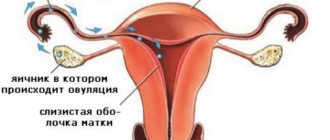What to do if it smears in the middle of the cycle? By assessing the nature of discharge from the female genital tract, it is possible to assess the woman’s health and the functioning of the reproductive system. Due to hormonal imbalance, which has a physiological cause, the consistency and color of the secretion often changes. If the discharge has acquired an unpleasant odor, and there is severe pain in the lower abdomen or lower back, you should immediately visit a gynecologist. The appearance of such unpleasant symptoms often indicates that a serious pathology is developing. At home, it is impossible to carry out a thorough diagnosis of the body and identify the factor that provoked the appearance of an unpleasant symptom. Medicines should be prescribed strictly by the attending physician, since self-medication only aggravates the course of the disease.
The main types of brown discharge
If it smears in the middle of the cycle, then it is necessary to analyze the volume and nature of the discharge. The intensity of the color also plays an important role. During treatment with birth control pills, darkish discharge may occur as the hormonal levels in a woman’s body change.
A light brown secretion appears after using a contraceptive or during the development of a pathological process in the pelvic organs. Under such conditions, droplets of blood from damaged vessels appear on the girl’s underwear.
Red-brown discharge often causes discomfort and causes a feeling of anxiety in girls after violent sexual intercourse. Insufficient formation of protective mucus during sexual intercourse often provokes the appearance of an unpleasant symptom.
At the very beginning of menopause, a red-brown secretion may appear, which will be released in small quantities from the woman’s genitals.
Absence of disease
Should you panic if you smear in the middle of your cycle? Under what conditions does brown discharge not indicate that a serious illness is developing?
- There is no need to panic if there is brown discharge before or immediately after your period. Quite often during ovulation, brown spotting mucus appears, this indicates that a mature egg has left the follicle. This phenomenon occurs most often on the 13th day of the cycle.
- When the egg attaches to the uterus, after successful conception, it often smears in the middle of the cycle. During the implantation of the fertilized egg into the endometrium, its vessels are slightly damaged. Droplets of blood stain the discharge. Under these conditions, minor discomfort or pain in the lower abdomen may occur.
- Early miscarriage. If separation of the fertilized egg from the endometrium occurs, minor bleeding occurs. The discharge becomes reddish-brown in color and continues for 3 days. However, often women do not even understand that they were pregnant and had a miscarriage.
- During puberty, girls smear brown in the middle of the cycle, since the hormonal levels have not yet been fully regulated.
- During menopause, menstruation becomes irregular as the functioning of the ovaries is disrupted. In the middle of the cycle, scant bloody-brown mucus may appear.
It is impossible to independently determine the factor that provoked the appearance of discharge from the genitals of a particular color and consistency. It is necessary to undergo a thorough medical examination and be tested for bacterial cultures. Based on the diagnostic results obtained, the gynecologist will determine the presence or absence of the disease.
Quite often it smears brown in the middle of the cycle due to an inflammatory process or the development of a malignant neoplasm. Under such conditions, it is important to start therapy in a timely manner, this will prevent the development of complications. At an early stage of disease development, therapy can be carried out without surgery.
Discharge is normal
Brown discharge in the middle of the cycle can be considered normal if it is scanty in nature, is not accompanied by pain and does not have an unpleasant odor. As a rule, they are observed before the start of critical days or immediately after their completion.
Such brown intermenstrual discharge indicates physiological changes in the female body.
Ovulation
The appearance of dark-brown secretion on the 14-15th day of the menstrual cycle (if it consists of 28 days) means that a favorable day has arrived for conceiving a child - ovulation. At this moment, the unfertilized egg leaves the follicle (the membrane in which it was located) and is ready to meet sperm. This natural process is accompanied by rupture of the follicular capsule (this phenomenon may be accompanied by slight hemorrhage), which causes the appearance of brownish discharge. However, care should be taken to ensure that the secreted liquid is not accompanied by a foul odor and is not intense. Otherwise, it is better to go to the hospital.
Pregnancy
Sometimes brown discharge, which is observed a few days after ovulation, means that fertilization of the egg has occurred and the woman will soon become a mother. It is very simple to explain this phenomenon: at the moment of attachment of the egg to the endometrium (the protective mucous layer of the uterus, which serves to secure the fertilized egg), minor damage to small capillaries occurs, as a result of which blood is removed from the body, coloring the secretory fluid. This is why a woman notices a small amount of unnatural color discharge on her underwear.
Women note that they often feel tightness in the lower abdomen during the attachment of the fertilized egg to the protective layer of the uterus.
Postpartum period, breastfeeding
The appearance of brownish discharge can also be observed during the postpartum period and breastfeeding. This is due to the fact that after the birth of a child, the female body and hormonal levels undergo serious changes. The menstrual cycle begins to recover, which explains the presence of brown secretion. Such a physiological phenomenon should not be accompanied by heavy discharge, pain and discomfort in the lower abdomen. If you have such symptoms, immediately visit the appropriate facility.
Use of contraceptives
The use of hormonal contraceptives (intrauterine device or pills) can also cause the secretion to appear in an unnatural color. Contraceptives act on a woman’s body by changing the amount of hormonal elements in it. This contributes to the appearance of brownish discharge. This phenomenon is considered normal when the discharge is not intense, which is not accompanied by unpleasant symptoms and lasts no more than 2-3 months.
Signs of pathology development
If, in addition to pathological discharge, other unpleasant symptoms appear, you should immediately visit a gynecologist. Pain in the lower abdomen and strange discharge from the genitals often indicate that a disease of the uterus is developing or that the appendages are inflamed. You should urgently consult a doctor under the following conditions:
- If brownish discharge appears that has an unpleasant odor, the girl is not taking hormonal medications.
- Painful sensations in the abdomen and back should be a cause for concern.
- Discomfort in the vagina, itching and burning often indicate that a disease is developing. If severe pain occurs during sexual intercourse, this is a sign of the development of a severe inflammatory process.
- Heavy discharge with blood that continues for several days should alert the girl.
If one of the signs appears, you should immediately visit your doctor and inform him about all the unpleasant symptoms that cause discomfort and interfere with leading your usual healthy lifestyle. Based on the diagnostic results obtained, the doctor will prescribe an individual treatment regimen.
Gynecological diseases and pathologies of pregnancy
Without serious knowledge of gynecology, it is difficult to independently determine why there is brown discharge, and there is significant discomfort and pain in the lower abdomen. But a woman can pay attention to the following signs, which should prompt an immediate visit to the gynecologist:
- The bloody secretion is too thick or watery.
- The amount of fluid released increases each time.
- The gasket gets wet in less than an hour.
- Blood is noted in the mucus systematically.
- Sexual contact is accompanied by pain.
- There is a high body temperature for no reason.
- There is an unpleasant odor.
- There is itching and burning sensation.
- There are no periods for a long time.
- A large number of clots are observed during pseudomenstruation.
Often the pathological condition of the reproductive system manifests itself by the release of a large amount of secretion with blood. However, gynecological pathologies do not always make themselves felt with clear symptoms, so they can be mistakenly correlated with the consequences of stress, starvation, inaccurate coitus and other relatively harmless provocateurs.
This secretion may occur instead of menstruation. This is a scanty spotting secretion (up to 50 ml), which is accompanied by the following symptoms:
- lower back pain;
- feeling of tightness or pain in the chest;
- shadow the lower abdomen or suprapubic area;
- dizziness;
- nausea.
The symptom may be caused by the following reasons:
- Hormonal disbalance.
- Pituitary dysfunction.
- Endometrial injury.
- Consequence of abortion.
- Protracted inflammatory process.
- Improper functioning of the endocrine system.
- Strong physical activity.
- Exhausting sports.
- Beginning of pregnancy.
The appearance of copious dark brown discharge cannot be associated with normal processes in the body. A similar sign indicates:
- inflammatory processes;
- sexual infections;
- ectopic (ectopic pregnancy);
- threat of miscarriage (from the first to the third trimester);
- endometritis;
- cystitis;
- endometriosis;
- cervical erosion;
- polyps;
- endometrial hyperplasia;
- benign neoplasms;
- cancer.
Diseases may not be diagnosed for a long time because symptoms do not appear immediately. A woman may not be aware of the pathology and may not observe any obvious signs. The appearance of dark brown discharge often indicates an already advanced case, which will be much more difficult to treat. It is for this reason that you should visit a gynecologist every six months without a good reason, and immediately if you have unnatural symptoms.
Problems with pregnancy and malignant tumors are considered especially dangerous, because in these situations there is a threat to the patient’s life without timely treatment or surgical intervention.
Cystitis
When the urethra or bladder itself becomes inflamed, blood is released, which is not related to diseases of the reproductive system. After frequent urination, a woman not only notices bloody discharge from the urethra, but also painful sensations in the lower abdomen or lower back. Additional symptoms of urethritis resemble the common cold. The following symptoms and characteristics of the secreted fluid should alert you:
- the appearance of blood in the urine;
- frequent urge to urinate;
- cloudy urine;
- high body temperature;
- vomiting and nausea.
Infection of a woman's genital organs in the absence of timely treatment causes prolonged inflammatory processes. Such violations affect the quantity and shade of vaginal secretion. To prevent complications, women need to know the nature of dangerous brown discharge and what infections they occur with.
- chlamydia;
- gonorrhea;
- trichomoniasis;
- candidiasis (thrush);
- genital herpes;
- mycoplasmosis;
- ureaplasmosis;
- bacterial vaginosis;
- gardnerellosis.
The occurrence of these diseases can be asymptomatic until the infection provokes inflammation. Each type of pathology has its own symptoms, but in any condition, brown vaginal discharge is a serious reason to visit a doctor and take a smear for microscopic examination.
Dark discharge can be considered normal or indicate the development of a pathological process in the body. In case of any ailments, you should consult a specialist and under no circumstances self-medicate. Only based on the results of the examination and tests, the doctor will prescribe effective treatment.
Why do hormonal imbalances occur?
For what reasons does it smear in the middle of the cycle? As medical practice shows, brown discharge most often appears due to hormonal imbalance and gynecological diseases.
There are several factors that can influence the occurrence of hormonal imbalance. Most often, girls over 25 years old face this problem. In addition to taking a hormonal drug, a disruption in the functioning of the endocrine glands can also cause an imbalance. The process of production of female sex hormones is regulated by gonadotropic hormones of the pituitary gland. Prolactin affects the level of estrogen and progesterone in a woman’s blood.
Quite often, hormonal imbalance occurs after surgery on the pelvic organs. After the operation, complications arise in the form of severe inflammation of the ovaries. Hormonal changes are also possible after termination of pregnancy. If sexual activity is absent or irregular, brownish discharge may appear. Emotional stress, depression or hysteria are often the main reasons for the appearance of this unpleasant symptom.
The most common causes of spotting
Spotting between periods can occur for various reasons; it is worth taking a closer look at each of them.
Ovulation
Around the 14th day of the menstrual cycle, a mature follicle bursts and an egg is released, ready for fertilization - this is how ovulation occurs. This may cause spotting in the middle of the cycle.
The egg moves through the fallopian tubes, where it will wait for the moment of fusion with the sperm. And the more fragile a woman’s vessels, the greater the likelihood of damage to the walls of the tubes and bleeding.
As a result, ovulation may be accompanied by brown spotting, as well as pain in the ovaries. This is a physiological process that is an acceptable norm.
Fertilization
If fertilization occurs after ovulation, the cell will go to the uterus to attach to the endometrial layer, which grows every cycle just for this purpose. Due to a violation of its integrity, a small amount of blood may be released, therefore, spotting will occur in the second half of the cycle. The nature of the discharge during fertilization is the same as during ovulation.
This brown spot is not dangerous at the moment of implantation of the fertilized egg; all subsequent discharge during pregnancy requires contacting a specialist.
Implantation of the embryo into the uterine wall
Taking hormonal medications
When taking oral contraceptives, a woman may experience spotting brown discharge. This most often occurs in the first three months of using the pills due to changes in hormone production levels.
In case of hormonal imbalance or premenopause, hormonal therapy is often carried out, which can also be accompanied by spotting in the middle of the cycle. There are also cases of bleeding when taking emergency contraception.
Find out more information about discharge when taking birth control pills in a separate topic on our website.
Installation of an intrauterine device
Sometimes spotting is associated with the installation of an intrauterine device. This contraceptive also affects the level of hormones in the body, which may cause spotting. Pink or red-brown, as a rule, indicates injury to the cervix during installation.
Injury to the mucous membrane
On the 10th day of the cycle, estrogen levels reach a maximum, and the walls of the vaginal vessels become more sensitive. When a woman already has fragile blood vessels, the risk of bloody marks on underwear or a pad after sex during this period increases significantly.
Sometimes rough sex contributes to vascular injury, and this can happen on any day of the cycle. Most often, the reason is that the partner is not very excited, which means that little lubrication is formed in the vagina, increasing the risk of injury to the mucous membrane. In such a situation, the discharge is usually scarlet in color and not abundant.
Exercise and stress
The cause of bloody spotting in the middle of the cycle can even be stress or severe physical activity. In this case, pink or brown marks most often remain on the gasket.
Allergic reaction
If it smears in the middle of the cycle, itching, burning and a complete absence of unpleasant odors from the vagina are observed, then most likely this is a manifestation of an allergic reaction. It can occur due to intimate hygiene products, underwear made of synthetic materials, lubricants and lubricants, condoms or oral contraceptives. The spotting, as well as the itching, will go away immediately after eliminating the irritant and taking an antihistamine.
After childbirth
If a woman is breastfeeding and has no longer had postpartum discharge, brown spotting may occur from time to time. This indicates hormonal changes occurring in the body and is not a pathology. After finishing breastfeeding or earlier, the menstrual cycle will be restored and the spotting will disappear.
You can read more about brown spotting in the middle of the cycle, which appears without pain, in a separate article on our website.
Common diseases
There are several main diseases that can cause the appearance of brown discharge from the genital organs in women, namely:
- Endometriosis is a common cause of mid-cycle spotting. With endometriosis, the structure of the endometrium is disrupted. Under such conditions, it begins to grow abnormally not only in the uterus, but also in the tube and cervix. Often grows into the peritoneum. Under such conditions, the blood vessels of the endometrium are damaged. Due to its active growth at the time of ovulation, it smears blood in the middle of the cycle. This indicates that a serious illness is developing. In addition, other unpleasant symptoms appear: pain in the abdomen, discomfort during sexual intercourse, and the duration of critical days increases. It is not advisable to carry out therapy without first consulting a doctor. Self-medication will cause complications.
- During the development of cervical erosion, spotting brown discharge is observed in the middle of the cycle. A brown secretion appears after sexual intercourse or during a gynecological examination of the cervix using a mirror or colposcope.
- With cervical polyps, brownish discharge is observed. They appear due to trauma to the tumor, twisting of the legs.
Physiological reasons
If the brown discharge is not accompanied by pain, it probably does not mean anything bad:
- Period. Spotting before and after menstruation is normal. A couple of days before your period, the accumulated dirt comes out. At the beginning of the cycle, remnants of the endometrium emerge from the uterus. The mucus has a light brown tint. The process lasts no more than 3 days.
- Ovulation. In the middle of the cycle, the follicle ruptures, in which an egg is formed. Because of this, vaginal secretions change color to light brown. The process continues for up to 72 hours.
- Adaptation to hormonal agents. In the first 3-4 months of taking oral contraceptives, the body gets used to hormonal changes. A similar process is observed after discontinuation of medications.
- Puberty. In the first 2-3 years, girls' menstrual cycle normalizes. During this period, periods are weak and irregular.
- Beginning of sexual activity. After defloration, several sexual acts are accompanied by minor bleeding. Because of this, the mucus takes on a brownish tint.
- Pregnancy. Attachment of the fertilized egg to the wall of the uterus causes rupture of blood vessels. In the first hours after this, red-brown discharge appears in women. At later stages the phenomenon is dangerous. It indicates placental abruption, threat of miscarriage or premature birth.
- Postpartum period. After childbirth, hormonal levels normalize, and the body begins to prepare for a new fertilization. The formation of the menstrual cycle occurs. Discharge after childbirth is spotting and irregular.
- The beginning of menopause. In middle-aged women, the endometrium atrophies and comes out with small amounts of blood. The process does not depend on the menstrual cycle and is accompanied by hot flashes, sweating and mood swings.
- Lack of personal hygiene. Lack of cleanliness in the intimate area leads to the growth of pathogenic microflora and changes in the acid-base balance. As a result, the color of the vaginal secretion changes.
- Injuries. Due to lack of lubrication during sexual intercourse, microcracks appear in the vagina. Damage also occurs after abortion and inaccurate gynecological examination.
Uterine fibroids
Due to mutation of cells in the uterus, a benign neoplasm develops. During the development of pathology, brownish discharge is often observed due to injury to the blood vessels of the uterus. The tumor is unable to grow into adjacent tissue. At the initial stage of the appearance of fibroids, there are no unpleasant symptoms. If the tumor grows significantly, then the woman smears blood in the middle of the cycle. In rare cases, uterine bleeding occurs (it can only be stopped with surgical intervention). It is important to regularly visit a gynecologist and take all necessary laboratory tests; this will help prevent the development of many diseases.
Ovarian cyst
During the development of an ovarian cyst, brown discharge often indicates that a large cyst has appeared. With this disease, the ovaries become inflamed and their functioning is impaired. The patient develops unpleasant symptoms:
- pain in the lower abdomen;
- body temperature rises;
- the nature of menstruation changes.
If timely treatment is not carried out, the cyst may rupture. In some cases, neoplasms acquire a malignant form.
If dark brown discharge appears in the middle of the cycle, or severe pain occurs in the abdominal area, you should immediately seek help from a specialist. The cyst can only be removed surgically.
Uterine cancer and other pathologies
Unlike fibroids, this neoplasm is actively developing. Symptoms of the pathology do not appear immediately. Brown discharge is the main symptom that occurs at the initial stage of the onset of the disease. It is important to visit a gynecologist in a timely manner and carry out therapy, this will help save the patient’s life.
For what other reasons does it smear brown in the middle of the cycle? An infectious disease that is sexually transmitted often causes a purulent inflammatory process, which is accompanied by colored discharge with an unpleasant odor. This symptom also occurs as a result of a disruption in the functioning of the reproductive system - hormonal imbalance. During the development of genital herpes and papillomatosis, this unpleasant symptom also often appears.
Pathologies
Unfortunately, brown discharge does not always appear due to physiological reasons. In some situations, such changes do not indicate the individual characteristics of the body, but the presence of pathologies of the reproductive system.
Most of the women who turned to a gynecologist for help were faced with the development of various diseases. Such changes do not occur unnoticed, therefore they are most often accompanied by:
- a large amount of mucus secreted;
- cutting pain that occurs in the lower back or lower abdomen;
- prolonged bleeding of various shades; unpleasant odor;
- irregular or scanty menstruation;
- elevated body temperature, nausea or vomiting.
The overall clinical picture may vary depending on the developing disease. The most dangerous pathologies that can cause red discharge in the middle of the cycle include endometriosis, uterine fibroids, cervical erosion, infections, oncology and hormonal disorders.
Endometriosis
With this pathology, the endometrium rapidly grows and spreads outside the uterus. As a result, brown discharge appears in the middle of the cycle. Moreover, the shade of such bloody discharge can vary from light pink to bright red.
Discharge with endometriosis appears cyclically, that is, every month. Also, increased discharge may occur after sexual intercourse. To avoid the development of more serious complications, it is necessary to begin treatment of the disease at an early stage.
Uterine fibroids
Myoma is a tumor that is localized in the muscle layer of the uterus. One of the signs of this pathology is the appearance of dark brown discharge in the middle of the cycle, which is characterized by abundant concentration. To accurately confirm the diagnosis, it is necessary to undergo an ultrasound examination, which will determine the size of the tumor and its location.
Fibroids are a slow-growing tumor that, when menopause occurs, begins to shrink in size, which will lead to a decrease in the amount of brown mucus produced. However, despite this, gynecologists recommend regularly monitoring the condition of fibroids.
Erosion
Erosion is a very common disease, which currently occurs in every third woman. With this pathology, wounds or scars form on the mucous membrane of the cervix.
In most cases, bleeding during erosion appears during sexual intercourse, as damage to blood vessels occurs. The amount of secretion released will depend on the size of the scar formation. If the erosion is large, it may bleed throughout the entire menstrual cycle, and not just in the middle.
Infections
There are a large number of infectious diseases that are sexually transmitted. All of them can provoke the formation of bloody mucus. It will be accompanied by a pungent odor, severe pain, itching and burning during urination.
When becoming chronic, the disease can cause fever, nausea or vomiting. To diagnose the pathology, it is necessary to take tests for infections. In this case, you can contact the laboratory and take an ELISA or PCR test. Both methods will indicate the presence of the disease, if any.
Some sexually transmitted infections, such as trichomoniasis or gonorrhea, can be diagnosed with a smear test. It is necessary to treat any type of disease as soon as possible, because a prolonged course can cause infertility.
Oncology
The prevalence of malignant tumors of the reproductive organs of women is gaining momentum. To make an accurate diagnosis, various techniques are used that can detect the development of cancer at an early stage. Symptoms that appear during the development of cancer include:
- the appearance of black discharge in the middle of the cycle, which is accompanied by the smell of rot;
- frequent localized pain in the lower abdomen that radiates to the lower back;
- disruption of the rectum, urinary system or other neighboring organs; lethargy and fatigue;
- drowsiness;
- scanty menstruation, which is accompanied by severe pain;
- unexpected “return” of menstruation after menopause;
- cervical stenosis.
Treatment tactics are selected exclusively by the oncologist, who is based on the patient’s general medical history.
Hormonal imbalances
The appearance of brown discharge may occur due to problems with the thyroid gland or adrenal glands. In this case, the discharge has a very thick consistency and a small amount.
Such disorders are most often caused by lifestyle, severe stress, and poor diet. As a result, the production of female hormones is disrupted. To eliminate this pathology, you will need the help of not only a gynecologist, but also an endocrinologist.
Thus, the appearance of brown discharge in the middle of the cycle does not always indicate the development of pathology. In order to be sure of your health, it is best to consult a gynecologist who will help eliminate the problem.
Inflammatory diseases of the uterus: symptoms
With endometritis, salpingitis, adnexitis, women often experience vaginal discharge mixed with blood. Among the main signs of diseases are:
- heavy or scanty periods;
- the presence of bleeding in the middle of the cycle;
- pain in the lower abdomen or back;
- increase in body temperature.
Even if there is no spotting in the middle of the cycle, gynecologists recommend undergoing a thorough medical examination every six months; this is the best prevention for any disease.
How to temporarily eliminate pain in the lower abdomen?
If brown discharge in the middle of the cycle is accompanied by severe pain in the lower abdomen, then it is necessary to take painkillers. You should know that analgesics only mask the disease, but do not affect the development of the pathological process, so you should definitely visit a gynecologist and not self-medicate. Among the most effective medications that will temporarily improve well-being and eliminate pain are:
- "No-Shpu";
- "Analgin";
- "Paracetamol";
- "Aspirin"
- "Spazmalgon";
- "Novalgin";
- "Nimesil".
To eliminate cramps and pain in the lower abdomen using No-Shpa, you need to take two tablets of the drug. Thanks to the medication, the tissues of the uterus relax, therefore the pain syndrome is effectively eliminated.
"Analgin" will help overcome pain of any nature. It is not recommended to take the drug systematically, as side effects may occur. If you do not follow the dosage of the medication, bleeding will occur.
Effective drugs
Paracetamol is one of the most common analgesics. Gynecologists often recommend taking this medicine in order to relieve aching menstrual pain.
If you notice your period in the middle of your cycle and your stomach hurts a lot, you should take a pill—Paracetamol can even be combined with hormonal medications. Aspirin is not recommended for systematic use to eliminate menstrual pain, as bleeding may occur. In rare cases, gynecologists recommend taking the drug on the 4th day of menstruation.
"Spazmalgon" is a popular drug that quickly eliminates pain. You should be aware that systematic use of the drug can affect blood pressure levels - it often lowers blood pressure. The maximum daily dose is 5 tablets, 1-2 pills at a time.
Note to women
Why does it smear in the middle of the cycle? The reason may be the development of a strong inflammatory process. If spotting systematically appears in the middle of the cycle, and there is severe pain in the lower abdomen or back, you should immediately visit a gynecologist. Most likely, this indicates that an inflammatory process is developing.
It is not recommended to buy medications on your own without first consulting a doctor and to self-medicate. This can only lead to the development of complications. Many gynecological pathologies at the initial stage of development manifest themselves in the form of bloody mucus from the woman’s genital organs, so you should not risk your health - it is important to go to the hospital immediately.
Various herbs and infusions have strong effects and contraindications, so you should not resort to traditional medicine without a doctor’s recommendation. If you smear in the middle of your cycle while taking birth control, you need to undergo a full medical examination. Only a doctor can identify the cause of the development of an unpleasant symptom.
Bloody discharge in the middle of the cycle - causes:
Brown discharge in the middle of the cycle may be due to ovulation, a period when the chances of getting pregnant are very high. If they are scanty, then this is considered a physiological norm, of course, if a gynecological examination does not reveal signs of other diseases. Usually in such cases the woman does not need treatment and such discharge is safe for women's health. Gynecologists divide any bloody, brown discharge in the middle of the cycle into two groups: uterine bleeding, intermenstrual bleeding.
Uterine bleeding
is a symptom of the following diseases and can occur in a woman at any age:
- Endometritis of the uterus
- Cervical erosion
- Fibroma
- Cervical cancer
- Uterine cancer
- Tumors of the appendages
- Internal adenomyosis
- Sarcoma
These are very serious diseases that require emergency care and medical intervention. If spotting regularly appears after sexual intercourse, the cause may be erosion or cervical cancer. If the discharge is accompanied by nagging pain in the lower abdomen, then this is one of the symptoms of inflammation of the inner layer of the uterus.
Intermenstrual bleeding in the middle of the cycle is due to other reasons:
If a woman takes hormonal contraception in any form (hormonal patch, birth control pills, hormonal ring), then intermenstrual bleeding is considered normal during the first 3 months of use. However, if hormones are not taken, the causes of slight bleeding may be as follows:
- Using medications that affect the menstrual cycle, such as taking supplements (either at the beginning or after stopping) that contain estrogen
- Use of drugs intended for emergency contraception (Ginepristone, Postinor, etc.)
- Presence of an intrauterine device
- Thyroid dysfunction, low levels of thyroid hormones
- Inflammation of the vagina due to sexually transmitted infections, STDs (sexually transmitted diseases)
- Genital injuries
- Hormonal imbalances - hyperprolactinemia, progesterone deficiency
- Polycystic ovary syndrome
- Some gynecological procedures
- Deep emotional shock, severe shock, stress, climate change
In a sexually active woman, spotting or spotting may indicate an STD. At the same time, they are accompanied by itching in the vagina, pain, and burning sensation when urinating.
If a woman is not protected, spotting may be a sign of an ectopic pregnancy or miscarriage. In this case, the woman usually has very severe pain in the lower abdomen. However, if slight brown, bloody discharge appears instead of menstruation, and then there is a delay, then pregnancy is most likely occurring.
With overly active, regular sex, microcracks may appear, and after intense physical activity or stress, sometimes there is brown discharge between periods.











